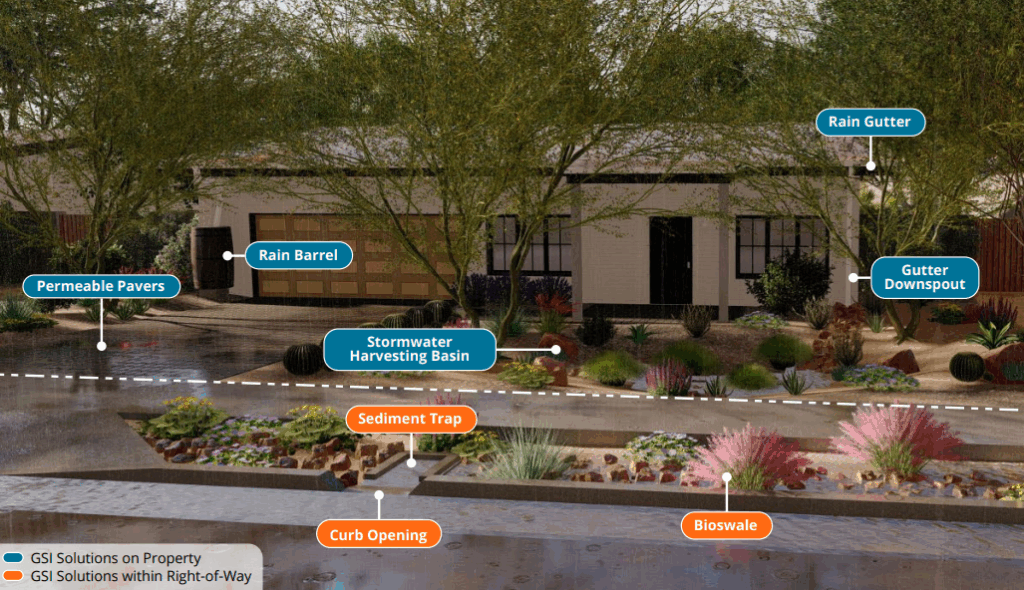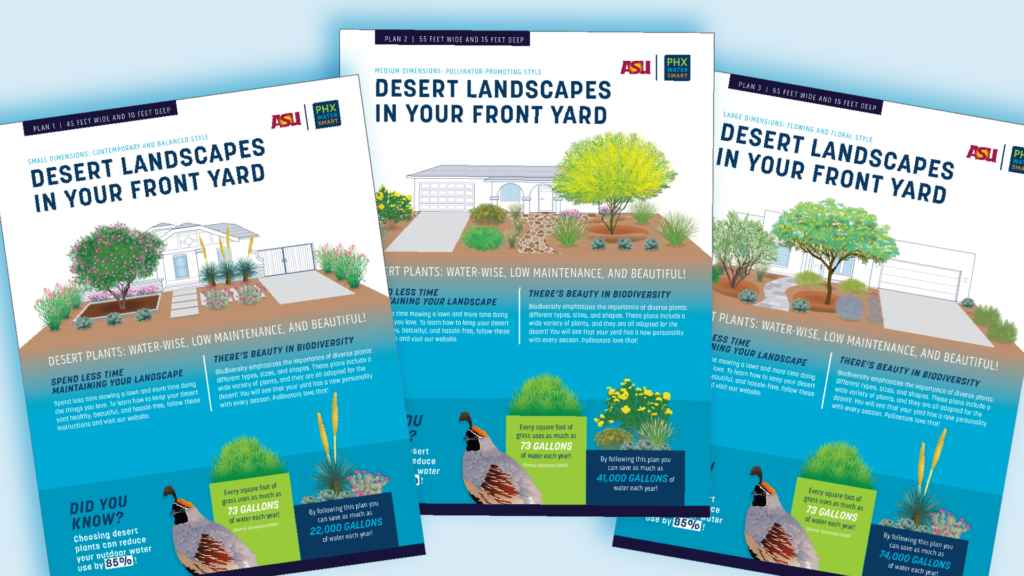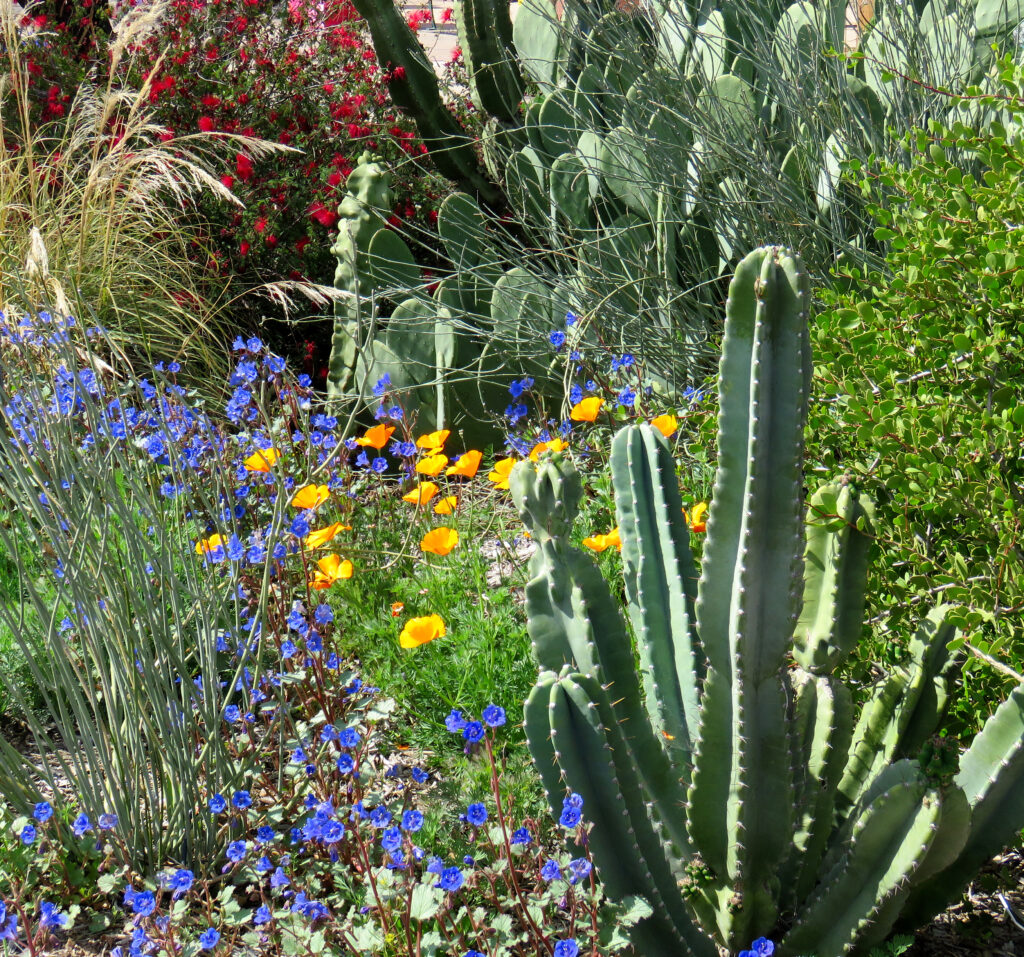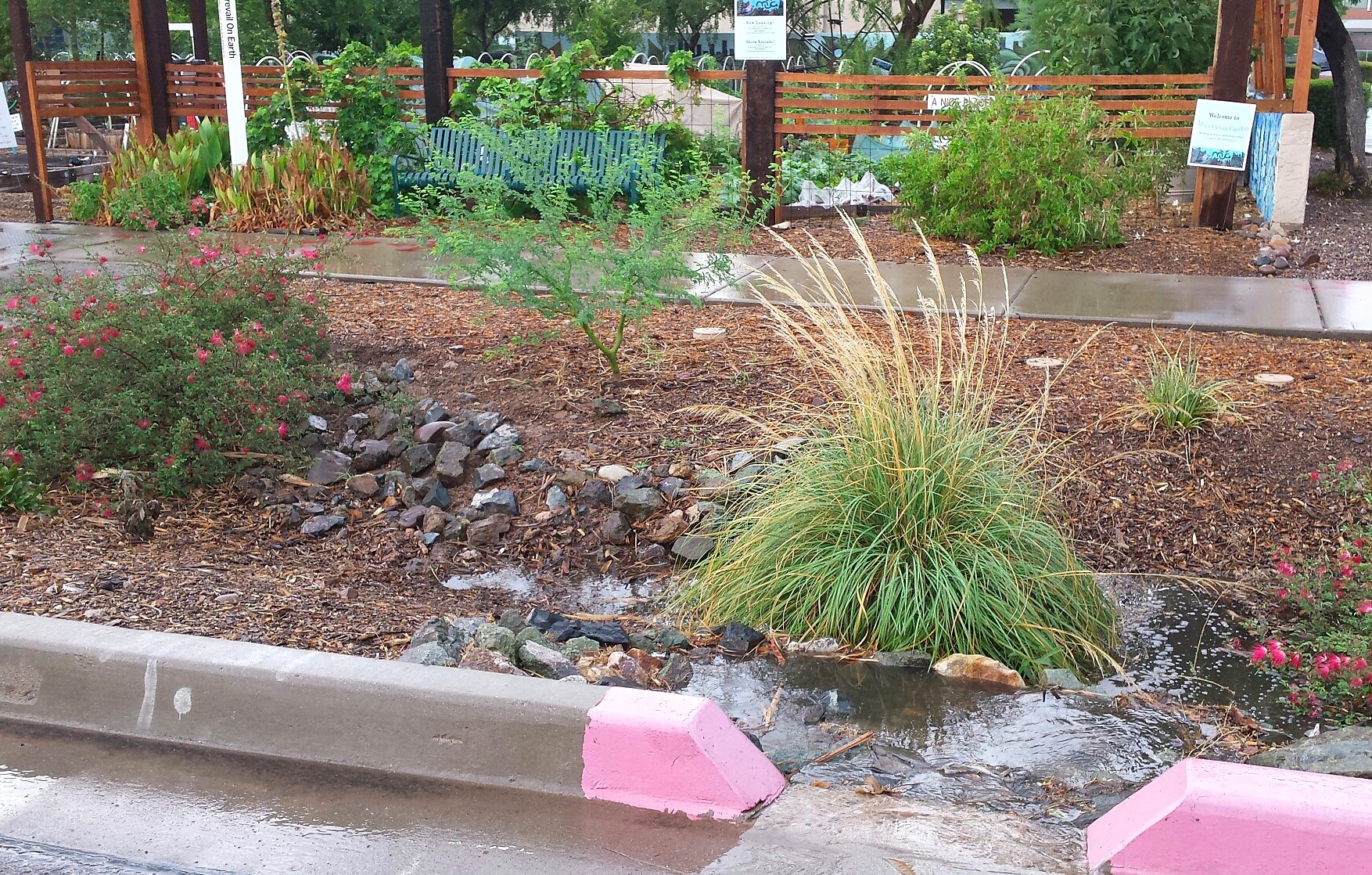Living in the Sonoran Desert means learning how to do more with less – especially when it comes to water. Among the most impactful of these solutions are green stormwater infrastructure and passive rainwater harvesting. From school campuses in the heart of the city to suburban homes in desert foothills, Arizonans can make every drop count.
What is Green Stormwater Infrastructure (GSI)?
Green stormwater infrastructure refers to the proactive capture of stormwater runoff with smart, low-impact methods. These landscaping features do more to keep rain where it falls; this makes water available for plants nearby instead of sending it far away to a retention basin. Rainwater harvesting features like basins, berms, and bioswales are able to collect, filter, and slow the movement of rainwater.
GSI is the desert’s answer to thrifty irrigation for water wise landscapes. According to the City of Phoenix’s Green Stormwater Infrastructure Handbook for Residents, it is a beautiful and effective way to lower irrigations costs and reduce risks of flooding. When you get smart about managing the ways that water flows in your yard, you find more water to support pollinators, less stormwater in the streets, and more water for the plants in your yard. This has an added benefit: mitigating stormwater pollution and combatting local heat. More rainwater, more native plants, and more shade!
Our favorite is passive rainwater harvesting, which is a GSI method that focuses on capturing and using rainwater where it falls. Rather than rushing down streets and sidewalks (and into storm drains), rainwater is able to be harvested right where it lands, absorbing into the ground to nourish plants and increase soil moisture. Passive rainwater harvesting works to reduce outdoor water use by making the most of the rain that we are lucky to get for free!
Phoenix launches Green Stormwater Infrastructure Handbook

The City of Phoenix released its new Green Stormwater Infrastructure Handbook for Residents online in January of this year. This handbook makes getting started easy, such as digging a shallow basin or forming a small “ring” under your tree (hint: basins and berms should not be sized according to your tree’s trunk. Look up at the canopy and you’ll know how far your tree’s roots may grow – the water you harvest should be spread just as far!). Passive rainwater harvesting can stop your rainwater and keep it where it is needed: in your yard, not in the street. Even with modest rainfall, a 1,000 square foot roof can collect around 4,800 gallons of water per year in Phoenix. How can you resist this “planting the water” approach?
Designing for Rain: Front Yard Transformations
If you are looking for inspiration in your front yard, the City of Phoenix and ASU’s Project Cities has released a set of free, customizable yard designs for passive rainwater harvesting. Your yard may be unique, but rainwater harvesting solutions can be customized no matter where you live. Whether you live on a slope, in a historic neighborhood, or in a ranch-style home near a floodplain, there is a way for you to save with the power of rain.

Each design incorporates features such as:
- Bioswales: Gently sloped, vegetated channels that “clean” and strategically send runoff to plants’ roots
- Basins and Berms: Simple, shallow depressions and mounds that capture rain and protect structures
- Permeable Driveways and Patios: Outdoor pavers that allow water to soak through their surface and into the soil beneath
- Rain Chains and Gutters: Can guide water that streams off of your roof into basins, delivering rainwater to give your plants a drink instead of washing away into streets and storm drains
The Power of Native Plants

Converting to a yard that utilizes GSI methods doesn’t mean you have to give up color or beauty either. In fact, rainwater and beautiful plants are better together! Here in the Sonoran Desert, we are fortunate to have a wide variety of native plants that vary in color, texture, form, and function. Are you a pink person? A fan of purple? Yellow, orange, red, or green? Whatever color is your favorite, we have a plant for you!
Still need convincing? Native plants also:
- Require less watering, fertilizer, and pesticides (save on your water bill, skip the fertilizer, and don’t worry about spraying chemicals)
- Create shade and improve air quality
- Support a greater abundance and diversity of pollinators, birds, and other wildlife
Caring for a native plant is oftentimes easier than thirsty, high maintenance plants that aren’t used to Arizona heat. Native plant establishment timelines vary between one year and three years, depending on the size of the plant (i.e., shrub vs. tree), and they will need some supplemental watering as they grow strong (see chart below).
Once your native plants are strong and happy in your yard, they may no longer need regular irrigation and could even thrive within the GSI feature independently, utilizing the captured stormwater throughout the year. Combining water harvesting and native planting is a wonderful, self-sufficient, and water-wise way to upgrade your landscape.
 For more information on native desert plants, check out the Landscape Plants for the Arizona Desert book.
For more information on native desert plants, check out the Landscape Plants for the Arizona Desert book.
Learn More: Hydrate Phoenix Online Classes
If you are excited to get started but aren’t sure where to begin, you’re in luck! In October of this year, Phoenix Water and the Watershed Management Group are offering a five-part online learning series that will walk you through the entire process – from planning your yard, to selecting native plants, and even growing native plants with berries, seeds, and fruits to eat!
Hydrate Phoenix classes include:
- Designing a Water Harvesting Landscape
- Selecting Native Plants for Multiple Benefits
- Vegetable Gardening in the Low Desert
- Cultivating Native Edibles
- Native Landscape Care
RSVP for these classes today to harvest some inspiration from rainwater experts and get started on your GSI journey. We look forward to seeing you there!
Lara Van Lith is a Water Resource Specialist at the City of Phoenix, one of 22 Water – Use It Wisely partners dedicated to offering water-saving advice and programs. Her work focuses on providing actionable, water conservation solutions and educational tools for Phoenix residents. She loves to paint and thrift, and her favorite desert plant is the Snapdragon Vine!
You may enjoy these additional resources on rainwater harvesting:
- Why Pay for Water When It’s Free?
- Discover Passive Rainwater Harvesting to Enhance the Sustainability of Your Landscape
- Top 5 Reasons to Collect Rainwater for Your Landscape



